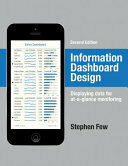
Dashboards have become a popular means to present critical information for rapid monitoring, but few do this effectively. When designed well, dashboards engage the power of visual perception to communicate a dense collection of information efficiently, with exceptional clarity. This can only be achieved, however, by applying visual design skills that address the unique challenges of dashboards. These skills are not intuitive; they must be learned. The author teaches a comprehensive set of effective design practices through examples that reveal what works, what doesn't, and why.